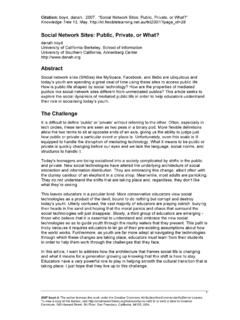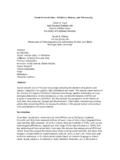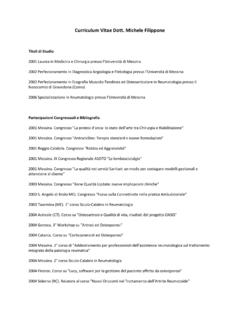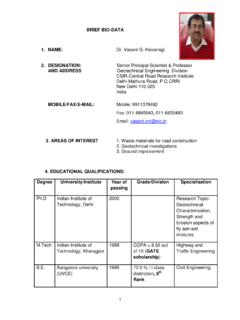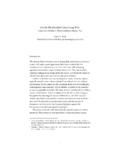Transcription of American Teen Sociality in Networked Publics - danah boyd
1 taken Out of context American Teen Sociality in Networked Publics by danah michele boyd (Brown University) 2001 (Massachusetts Institute of Technology) 2002 A dissertation submitted in partial satisfaction of the requirements for the degree of Doctor of Philosophy in Information Management and Systems and the Designated Emphasis in New Media in the Graduate Division of the University of California, Berkeley Committee in charge: Professor AnnaLee Saxenian, Chair Doctor Mizuko Ito Professor Cori Hayden Professor Jenna Burrell Fall 2008 taken Out of context : American Teen Sociality in Networked Publics Copyright 2008, Some Rights Reserved (See: Appendix 3) danah michele boyd 1 Abstract taken Out of context : American Teen Sociality in Networked Publics by danah michele boyd Doctor of Philosophy in Information Management and Systems with a Designated Emphasis in New Media University of California, Berkeley Professor AnnaLee Saxenian, Chair As social network sites like MySpace and Facebook emerged, American teenagers began adopting them as spaces to mark identity and socialize with peers.
2 Teens leveraged these sites for a wide array of everyday social practices gossiping, flirting, joking around, sharing information, and simply hanging out. While social network sites were predominantly used by teens as a peer-based social outlet, the unchartered nature of these sites generated fear among adults. This dissertation documents my ethnographic study of American teens engagement with social network sites and the ways in which their participation supported and complicated three practices self-presentation, peer Sociality , and negotiating adult society. My analysis centers on how social network sites can be understood as Networked Publics which are simultaneously (1) the space constructed through Networked 2 technologies and (2) the imagined community that emerges as a result of the intersection of people, technology, and practice. Networked Publics support many of the same practices as unmediated Publics , but their structural differences often inflect practices in unique ways.
3 Four properties persistence, searchability, replicability, and scalability and three dynamics invisible audiences, collapsed contexts, and the blurring of public and private are examined and woven throughout the discussion. While teenagers primarily leverage social network sites to engage in common practices, the properties of these sites configured their practices and teens were forced to contend with the resultant dynamics. Often, in doing so, they reworked the technology for their purposes. As teenagers learned to navigate social network sites, they developed potent strategies for managing the complexities of and social awkwardness incurred by these sites. Their strategies reveal how new forms of social media are incorporated into everyday life, complicating some practices and reinforcing others. New technologies reshape public life, but teens engagement also reconfigures the technology itself. i This dissertation is dedicated to my beloved advisor, Peter Lyman (1940 2007), for all of the support, guidance, and love he provided along the way.
4 I could not have asked for a better friend, mentor, and partner in crime. May he rest in peace knowing that I finally finished. ii Table of Contents Chapter 1: Introduction 1 My Dissertation The Social Construction of Technology and Locating Networked Public and Teenagers and Publics , The Structure of Networked Properties of Networked New Dynamics Resulting from Networked Chapter 2: Choose Your Own Ethnography 42 Ethnography in Ethnography and the Networked My Field Site in and of From Youth to American From Networked Publics to MySpace and From the United States to Teens Homes and Locating Myself in My Field An Imperfect Field My Online Data and iii Fieldwork in Less Structured External Complexities of Online Analyzing Relationships and Chapter 3: Social Network Sites and Social Media 92 The Rise of Social Network MySpace and Facebook and By the Numbers and in Participation in Negotiating Multiple Communication Teen vs.
5 Adult Social Media Chapter 4: Writing Oneself into Being 119 Locating Writing Identity into Being The Art of Profile Creation and Techniques for Bedroom Culture and Varying Degrees of Self-Presentations in Performing Falsehoods Deception, Play, or Control?..148 Motivations for Providing Inaccurate Legal and Technical Safety through Controlling Access: Public or Private?..159 Managing Identity in Networked iv Chapter 5: Friendship, Status, and Peer Worlds 170 Peer Relations and Teen Pressure to Participate: Signing Up and Opting Pressure to Failure to MySpace vs. Facebook: Social Categories and Networked Adoption Distinctions and Social Reinforcing Offline Social Status and Digital Public Displays of Connection and Strategies for Hierarchies of Status Battles and Peer Peer Sociality in Networked Chapter 6: Power and Control 241 Social and Structural Contemporary Adult-Teen Household Engaging with Teachers, Youth Pastors, and Other Trusted Fears and Moral The MySpace Moral Teen Responses to a Culture of Access, Privacy, and Restricting Access and Limiting Network Effects of In the Pursuit of v Chapter 7: Lasting Impressions 293 Lessons from the Everyday Lives of The Significance of The Future of Networked Bibliography 304 Appendix 1: Brief Descriptions of Teens 337 Appendix 2: Features and Functionality 376 Appendix 3.
6 Creative Commons License 385 vi Acknowledgments taken out of context , I must seem so Ani DiFranco, Fire Door While writing a dissertation is one of the most isolating activities imaginable, I was never truly alone. I had the constant support and encouragement of family, friends, colleagues, and mentors. I cannot even begin to express my gratitude for their willingness to put up with me during these years. The love and support that I received from my partner Gilad during this process exceeded my wildest dreams. He lived with me throughout this process and bore the brunt of my exhaustion, confusion, and frustration. Without complaint, he responded with chicken noodle soup and hugs. On my most recent birthday, he surprised me with a party and a cake. When I asked why the number of candles did not equal my years since birth, he explained that he had subtracted my time in graduate school. Gilad s love, humor, and patience made it possible for me to keep going and, for that, I am eternally grateful to him.
7 I am tremendously thankful for all of my family and their love. I am especially appreciative of my brother Ryan s willingness to be there for me even when I was most crazy. And to my grandparents who have embraced my insanity as proof that I am family ; their willingness to go for an adventure and attend my graduation prompted me to work harder and faster. Finally, I would not be who I am today vii without my mother Kathryn. Mom this document is the answer to your persistent question, Are you done yet? Finally, w00t! When friends ask about my dissertation committee, I refer to Mimi Ito, Cori Hayden, Jenna Burrell, and Anno Saxenian as the goddesses. I have had the great fortune of working with four brilliant women who have guided me and shaped me with boundless patience and encouragement. Their intellectual engagement with my ideas and support of my endeavors is what made this process worth it. I have been surrounded by a great group of scholars, researchers, and thinkers who have helped me stay grounded.
8 Ronen Barzel, Elizabeth Churchill, Cory Doctorow, Liz Goodman, Jo Guldi, Hannah Rohde, Irina Shklovski, and Wendy Ju, have helped me find humor in this process while always being there with an understanding shoulder on which to cry. Judith Donath, Nicole Ellison, Scott Golder, Bernie Hogan, Eszter Hargittai, Amanda Lenhart, Liz Lawley, Alice Marwick, Clay Shirky, Fred Stutzman, and Michele Ybarra provided ongoing counsel about researching social network sites and helped me believe in what I was doing. Marc Davis, Henry Jenkins, Barrie Thorne, Nancy Van House, and Barry Wellman were always there to challenge me to think wider and deeper while providing ongoing mentorship and support. During this process, I had the great fortune of calling many different communities home. The iSchool at Berkeley was an intellectually stimulating environment where I grew as a scholar. I was lucky to learn from brilliant faculty viii and be surrounded by a fantastic cohort of fellow PhD students.
9 I am especially grateful to Joe Hall, Dan Perkel, Vivien Petras, Dilan Mahendran, Christo Sims, and Yuri Takhteyev for asking me tough questions and helping me work through the answers. My fellowships at the USC Annenberg Center and Harvard Berkman Center were key to exposing me to new ideas, and I am especially grateful to Jonathan Aronson, Dan Gillmor, John Palfrey, Doc Searls, Wendy Seltzer, Jimmy Wales, David Weinberger, Jonathan Zittrain, Ethan Zuckerman, and the Digital Natives team for their crazy ideas. Working at Yahoo!, Google, and helped me get an inside scoop on how technology is produced and disseminated and I am particularly indebted to Adam Bosworth, Ian Rogers, Marc Pincus, and Evan Williams for believing in me. I am also grateful to my agent Wes Neff for putting me in front of a wide range of audiences who forced me to think through my ideas. I was lucky to do my fieldwork as part of a much larger project funded by the MacArthur Foundation concerning youth, learning, and new media.
10 I am indebted to the MacArthur Foundation for funding this project and am especially thankful to John Seely Brown, Ben Stokes, and Connie Yowell for their commitment to my research. It was a blessing to embark on this project surrounded by a community of like-minded scholars working on similar studies. The 28-person Digital Youth team assembled by Mimi Ito, Peter Lyman, and Michael Carter provided the ideal intellectual space for working out the puzzles in my dissertation. I am especially grateful for long conversations and debates with Becky Herr-Stephenson, Heather Horst, and CJ Pascoe. ix I am beholden to Sam Jackson and Ann Murray, my research assistants, for tirelessly tracking down online content for me and to Karen Bleske, my copy editor, for making sure this document is legible. All of my mistakes in this document are my fault; I had the wise idea of doing just one more revision before submitting. Throughout the country, various adults helped me connect with teenagers in their communities, including Carrie Benseler, Irma Carranza, Ben Chun, Doug Elmer, Anastasia Goodstein, Janet Hawk, Tom Hicks, Rachel Hunt, Zayira Jordan, Dina Kraemer, Hollie Mendenhall, Jeff Plinsky, Julie Tereshchuk, and Kristi Williams.

